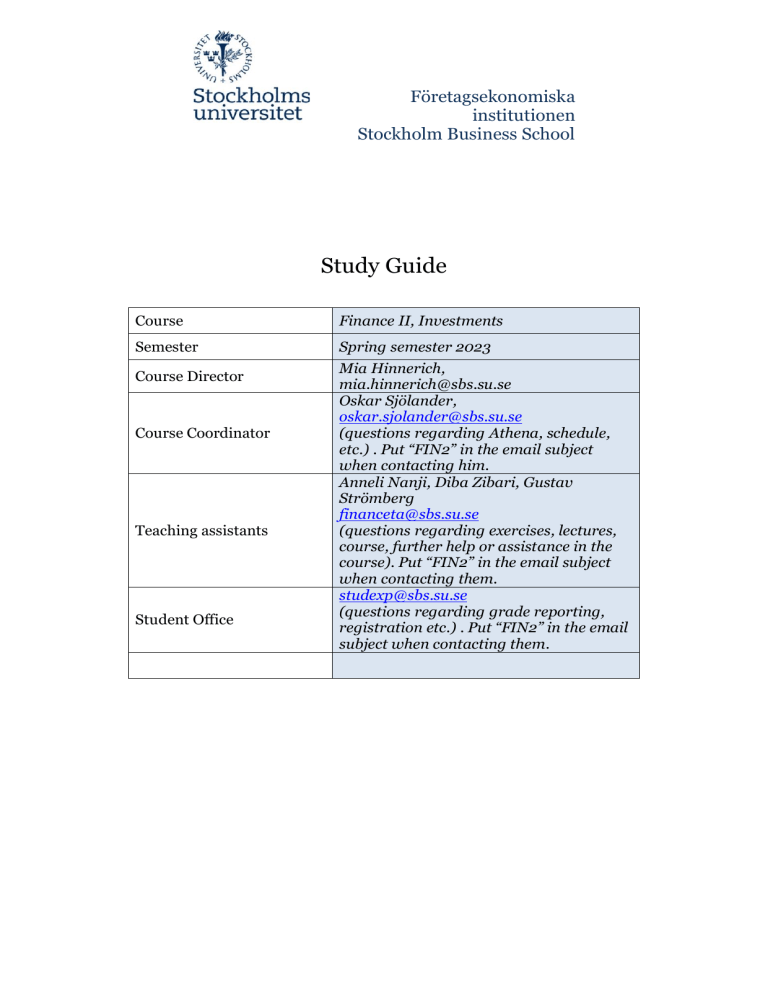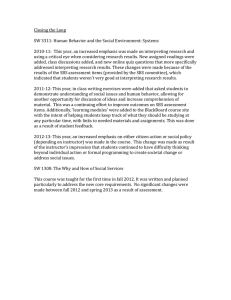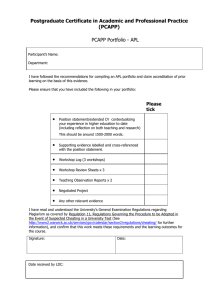
Företagsekonomiska institutionen Stockholm Business School Study Guide Course Finance II, Investments Semester Spring semester 2023 Course Director Course Coordinator Teaching assistants Student Office Mia Hinnerich, mia.hinnerich@sbs.su.se Oskar Sjölander, oskar.sjolander@sbs.su.se (questions regarding Athena, schedule, etc.) . Put “FIN2” in the email subject when contacting him. Anneli Nanji, Diba Zibari, Gustav Strömberg financeta@sbs.su.se (questions regarding exercises, lectures, course, further help or assistance in the course). Put “FIN2” in the email subject when contacting them. studexp@sbs.su.se (questions regarding grade reporting, registration etc.) . Put “FIN2” in the email subject when contacting them. Content 1. Course Content 2 2. Intended Learning Outcomes 2 3. Education 2 4. Forms of Examination 3 5. Literature 6 6. Cheating and Plagiarism 6 7. Additional Information 7 1 back to Content 1. Course Content The importance of the knowledge of investment processes and financial securities has risen over the last decades as the importance of the financial industry has increased and individuals have been given more responsibility to invest their pension contributions. In recent years the importance of considering Environmental, Social and Governance issues regarding investments has increased. Topics discussed in the course include financial markets, portfolio theory, financial instruments, market efficiency, behavioural finance, portfolio performance evaluation international diversification and principles for responsible investments. The course provides an increased understanding of financial instruments, portfolio management, investor psychology and investment processes. The course consists of lectures, seminars, tutorials, and a portfolio management exercise. 2. Intended Learning Outcomes back to Content Intended Learning Outcomes The overall aim of the course is to introduce the students to financial markets, asset management practises, investment analysis, and performance evaluation. Upon completion of the course, students shall be able to: Knowledge and understanding 1. recognise and describe financial markets, market participants, and financial instruments; Skills and abilities 2. solve financial problems related to the portfolio choice of an individual investor; 3. perform security and portfolio performance analysis; Judgement and approach 4. assess the attractiveness of different investment opportunities; 5. evaluate the performance of investment portfolios. 6. be familiar with principles for responsible investing. back to Content 3. Education The course workload is 200 hours equivalent to 7,5 ECTS (40 hours per week equivalent to 1,5 ECTS). 2 The course consists of a combination of lectures, seminars and group work and requires a significant portion of self-study on the part of students. Assessment for the course will be continuous and is carried throughout the different activities of the course. The teaching assistants have on-campus open sessions and office hours for additional and individual help in the course. Office hours can be broadcasted via zoom. The language of instruction is English. Please note that all teaching and learning activities - such as lectures, seminars, assignments and assessment tasks – are carried out in English when the language of instruction is English. The teaching activities are planned to be carried out on-campus. Some teaching activities such as the calculation exercises and office hours will also be broadcasted live in Zoom. The plan is preliminary and may change due to COVID-19 and SBS policy changes. More information will follow on the date of the first lecture. Information and links to the teaching activities in Zoom will be available on Athena under Planning/Detailed schedule with reading instructions and zoom links. 4. Forms of Examination back to Content Assessment Assessment for the course will be continuous and is carried throughout the different course activities. Each assessment task is weighted in relation to its importance in the overall assessment of the course. The students’ results from the different assessment tasks are added up to a total course score that will then translate into the final grade for the course. Assessment tasks The course contains the following weighted assessment tasks: 1. Individual final exam: assesses intended learning outcomes 1, 2, 3, 4, 5, 6; constitutes 80% of total course points. You need to be registered for the exam in Ladok at least 8 workingdays before the exam. 2. Multiple Choice Questions (MCQ) assignment: assesses intended learning outcomes 1, 2 and 4; constitutes 10% of total course points. This assignment is to be done individually and completed no later than April 25, 2023 @ 09:00 3. Portfolio management assignment: assesses intended learning outcomes 1, 2, 3, 4, 5, 6; constitutes 10% of total course points. This assignment is to be done in groups of 2-3 students and completed no later than April 21, 2023 @ 09:00. After completion of the course, students will receive grades on a scale related to the intended learning outcomes of the course. Passing grades are A, B, C, D and E. Failing 3 grade is F A course comprises 0–100 course points. Receiving a final passing grade requires ≥ 50 course points. The scale for the final grade is tied to fixed score intervals: A: 90-100; B: 80-89; C: 70-79; D: 60-69; E: 50-59; F: 0-49. The grades correspond to the total score points a student obtains (over a total of 100) for all the weighted assessment tasks combined as part of the continuous assessment for the course. Each assessment task is awarded 0–100 points. The score for a single assessment task is the number of points multiplied by its percentage weight, and the combined total of score points for all weighted assessment tasks for the course are added up to a final score between 0 and 100 which then translates into a corresponding final course grade between A and F. Assessment task 1, the final exam, is assessed on a 100-point scale. Assessment task 2, MCQ, consists of 60 multiple choice questions (10% of total course points). - Pass: at least 50 correct answers = 100 points Fail: less than 50 correct answers = 0 points Assessment task 3, the portfolio assignment, is assessed on a 100-point scale in two intervals: - Pass: = or>50% = 100 points. Fail: <50% = 0 points. The student is responsible for completing the course’s assessment tasks: that a sufficient amount of course points is earned, and a passing course grade is obtained. Assessment task 1, the exam, can be taken twice: 1) during the course’s first scheduled occasion; and, if a passing result (≥ 50 course points) was not achieved at the first occasion, 2) at the course’s second, scheduled occasion. All other assessment tasks are offered once during the course. A passing grade (A–E) in the course is obtained when a student has achieved ≥ 50 course points. A failing grade (F) in the course is obtained when a student has not achieved ≥ 50 course points: - If <50 course points are achieved, a grade F is obtained, implying that the entire course must be retaken and that previously acquired course points are forfeited. Re-registration implies that: first-time registered students have priority access to the course's group registration; - Assessment task 1, the exam, can be re-assessed without attendance at any of the course's other learning activities and without points from the course’s other assessment tasks are accredited. Students receiving a passing grade may not retake the final examination or complete a previously not completed assessment task to attain a higher grade. A passing grade may not be turned into a failing grade upon the request of a student. 4 Assessment criteria Assessment criteria are designed as overall assessments, combined qualitative descriptions of what the student is expected to do in order to demonstrate how well the course’s learning outcomes are achieved. The assessment criteria are based upon the general abilities as expressed in the degree objectives of the Higher Education Ordinance (appendix 2, System of Qualifications). The list of abilities below is a compilation of these degree objectives. To pass the course (grade E) students should demonstrate general ability to: - recall, understand and explain course content, the course subject and its scientific basis and methodology; - apply course content; - critically analyze course content; - problematise course content; - meet standards of written presentation and formal accuracy. The following assessment criteria are used to decide to what extent students have demonstrated these abilities and hence fulfil the course’s intended learning outcomes, whereby a grading decision can be made. A higher grade-level presupposes the abilities at lower levels. A (Excellent) The student demonstrates ability to evaluate and relate to the content of the course from a comprehensive, critically reflective perspective, as well as to transfer and apply insights in new, meaningful contexts. B (Very Good) The student demonstrates ability to, from an overarching and coherent perspective of the field, understand and use concepts to explain how different aspects of the course relate to each other, interconnect and become meaningful. C (Good) The student demonstrates ability to discuss the content, tasks and complex issues dealt with in the course from several well-developed but mainly independent perspectives. D (Satisfactory) The student demonstrates satisfactory ability to discuss the content, tasks and complex issues dealt with in the course in a way that, albeit in-depth and elaborate, is decidedly one-dimensional. E (Sufficient) The student demonstrates sufficient ability to discuss the content, tasks and complex issues dealt with in the course in a way that is decidedly one-dimensional. F (Fail) The student’s knowledge, skills and abilities display major flaws, overall or in significant parts. 5 back to Content 5. Literature Required Reading Zvi Bodie, Alex Kane and Alan J. Marcus, Investments, International Student Edition: McGraw-Hill/Irwin, 12th edition with online material ISBN: 9781447084280. Comment: This edition contains an access code to the online material including exercises with solutions. The publisher will record a short youtube video containing the most important information regarding the online material. The video is available on Athena under Resources/General/Textbook. A selection of academic articles Reading instructions Reading instructions are provided with the detailed schedule on Athena under headline “Plans/Planering if you then click on Schedule. There you also find the links to the lectures. To see all the information it is important that you have the correct setting: At the top of the page Plans/Planering make sure you have chosen "all" ("alla") to see all events (alla händelser) Then click on schedule. 6. Cheating and Plagiarism back to Content Cheating and plagiarism is a very serious offense at Stockholm Business School. All staff are obliged by law to report all suspicions of cheating to the Vice Chancellor at Stockholm University, as a matter for the Disciplinary Committee at Stockholm University. According to the Higher Education Ordinance (chapter 10, section 1), disciplinary action may be invoked against students who “by the use of prohibited aids or other means attempt to deceive during examinations or other forms of assessment of student performance”. E.g. Cell phones during “sit in” exams (written examination) are strictly forbidden, as well as notes, dictionaries and other prohibited aids. Read the cover of your “sit in” exam carefully to find out what aids are prohibited during your exam. Plagiarism is a form of cheating or deceit. The ordinance covers all types of graded work, such as written examinations, take-home examinations, quizzes and written assignments, as well as unauthorized collaboration in connection with such work. Plagiarism refers to the deliberate use of someone else’s work, regardless of whether this work has been published, and passing it off as your own without marking quotations or indicating the 6 source. Self-plagiarism refers to the deliberate use of self-written text for another course without marking quotations or indicating the source. Plagiarism involves: • • • • • • paraphrasing (a restatement of the meaning of a text or passage using other words) someone else’s text without referencing the original paraphrasing or rewriting someone else’s text and referencing the original, but where the rewrite is nonexistent or too close to the original reusing other students’ work, e.g. seminar assignments, take-home examinations, essays or papers without referencing the original reusing self-written text, so called “self-plagiarism”, without referencing the original using text from articles, books, websites or other types of documents available on the Internet without referencing the original translating a text from one language to another without referencing the original. Stockholm Business School uses the text comparison tool Urkund to verify the originality of graded texts. Because of this, students should regularly and according to academic practice carefully reference their use of their own and other people’s sources. All assignments submitted via Athena are checked for originality through Urkund. 7. Additional Information back to Content Exemption from an assessment task is granted if the student presents a valid reason and a written certification (illness and a medical certificate), whereupon the student may re-sit the assessment task at a later date while maintaining previously acquired course points. Application for exemption should be submitted to the Director of Studies immediately after or during planned absences, well before the date when the assessment task is carried out. A granted exemption expires at the end of the immediately following semester. Students in need of targeted support Students in need of targeted support have the opportunity to apply for a Nais certificate via Stockholm University. If you have a Nais certificate and are going to study at SBS this semester, you should always send the certificate to studentstod@sbs.su.se. You will then receive information about which of your recommendations SBS will be able to grant, as well as whether you also need to contact and inform the course director. Note that there may be course-specific circumstances which make it difficult for SBS to provide all recommended forms of support.” 7

